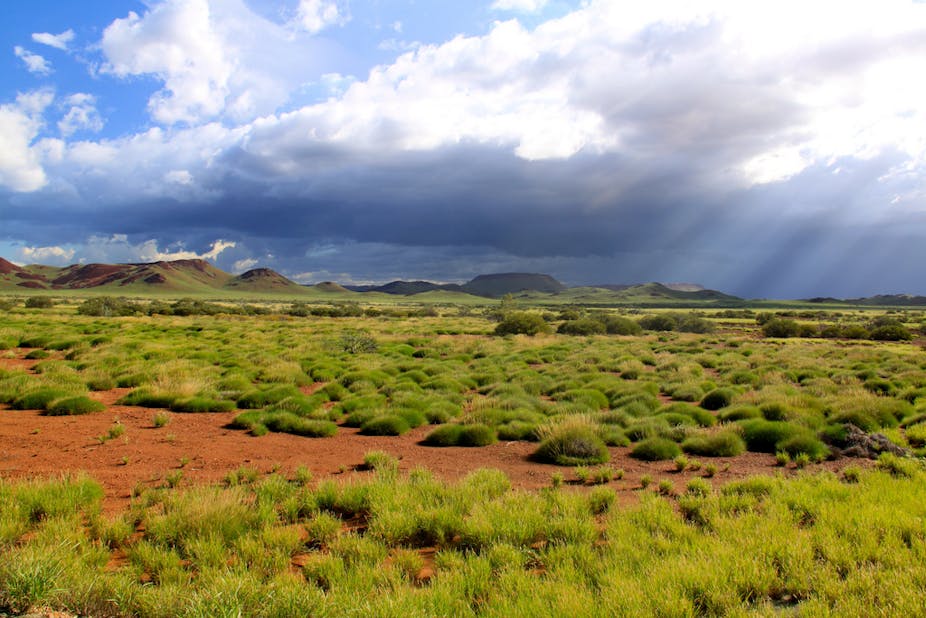A study published in Nature Geoscience yesterday reports the discovery of 3.4 billion-year-old microbial cells in ancient sandstones in Western Australia’s Pilbara region.
Some headlines have suggested the fossils are the oldest ever discovered and while such claims are slightly misleading, the fossils are certainly not insignificant.
So what are these fossils and what do they look like?
First of all, they’re tiny – around a hundred-thousandth of a metre (10 micrometres) across. They are hollow spherical and tubular structures composed of carbon-rich matter.
According to the research team that made the discovery – led by David Wacey of the University of Western Australia – the structures are arranged in small chains and clusters and preserved in silica cements between grains of sand.
Their composition, structure, degradational fabric (i.e. the way they are preserved) and the fact they’re clustered together strongly suggest the objects represent the partially degraded remains of microbial cells.
Significantly, we know the fossils were formed at the same time as the surrounding rock (a characteristic known as “syngenicity”) and, by deducing the age of the sandstone, the researchers were able to ascertain the age of the fossils.
Why is this discovery significant?
For a start, microbial cells are only preserved in the fossil record in exceptional circumstances.
Convincing examples dating from the first 3.6 billion years or so of Earth’s 4.5 billion year history were unknown prior to the 1950s.
Several decades of continuous finds have since provided an extensive microfossil record for the Precambrian period (from the earth’s formation until about 542 million years ago).
As said, the fossils described by Wacey and colleagues are not the oldest evidence of life on Earth.
That title may belong to samples discovered in heavily metamorphosed rocks (rocks that have changed in form over time) in Greenland that are around 3.8 billion years old.
Nor are the fossils described by Wacey and colleagues the oldest microfossils.
In 1993, filamentous (rod-shaped) microfossils bearing some resemblance to modern phototrophic bacteria (i.e. organisms that derive their energy from photosynthesis) were found in 3.5 billion year old rocks in the same region of WA.
That finding sparked an ongoing debate with regards to their “biogenicity”. Put simply, there was some suggestion the chemical structures were unrelated to life.
Similarly ancient evidence for very early life is provided by stromatolites – layered sedimentary features formed by microbial communities and preserved in many early sedimentary rocks. Some stromatolite communities are as old as 3.5 billion years.
Older evidence of life aside, the discovery made by Wacey and colleagues is a significant contribution to the early fossil record.
Intriguingly, it provides a glimpse of the metabolisms that were employed by some of the earliest life on Earth.
They found that sandstone sediments preserve iron sulfide grains (also known as “detrital pyrite”), and that these microfossils are closely associated with additional pyrite within the sandstone.
The presence of detrital pyrite and sulfur-based compounds in the sandstone suggests a sulfur-cycling ecosystem that was at work in an oxygen-poor environment 3.4 billion years ago.

Is there anything older?
So, are we likely to find fossil evidence for life that’s even older than what we’ve found already?
The answer: an unequivocal “maybe”.
To understand this answer we must consider the vagaries of plate tectonics, which ensure the constant recycling and alteration of all rocks.
This means the further we look back into geologic time, the fewer and more obscured the rocks become.
In fact, we currently know of no well-preserved rocks older than about 3.5 billion years, and the oldest known rocks formed on Earth are no more than about 4 billion years old.
This fact provides obvious constraints on the age of the oldest fossils we are ever likely to discover. Nonetheless, more surprises may still lie waiting.
Paleontologists generally don’t look for microfossils in sandstones because in modern-day environments any organisms that are buried in these sediments are quickly decomposed.
The discovery made by Wacey and colleagues is therefore a surprise, and suggests conditions in the early Archean period (roughly 3.8 billion to 2.5 billion years ago) were different from those of today.
For one, aerobic decomposition could not take place in an atmosphere that was practically devoid of oxygen – which appears to have been the case 3.4 billion years ago.
Furthermore, silica may have been so abundant in the oceans that it precipitated out (went from being dissolved in sea water back to a solid) and readily entombed organic matter on shallow sea-floors.
The discovery is also a significant development in the search for life on Mars.
Sandstones occur on the red planet and are probably better preserved than the oldest examples known on Earth, in part because plate tectonics are no longer active on Mars.
In this way, the recent discovery could provide great insight into what we could, and should be looking for on the red planet.
Rock on.
Further reading
- “Earth’s earliest records of life” - lecture by Roger Buick of the University of Washington

